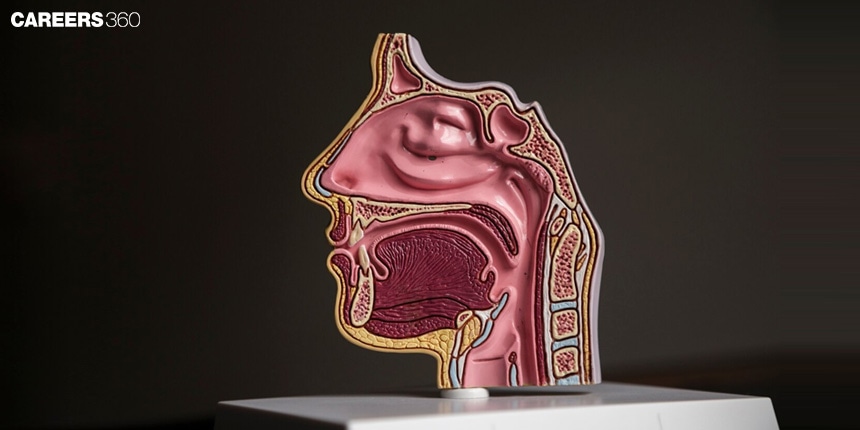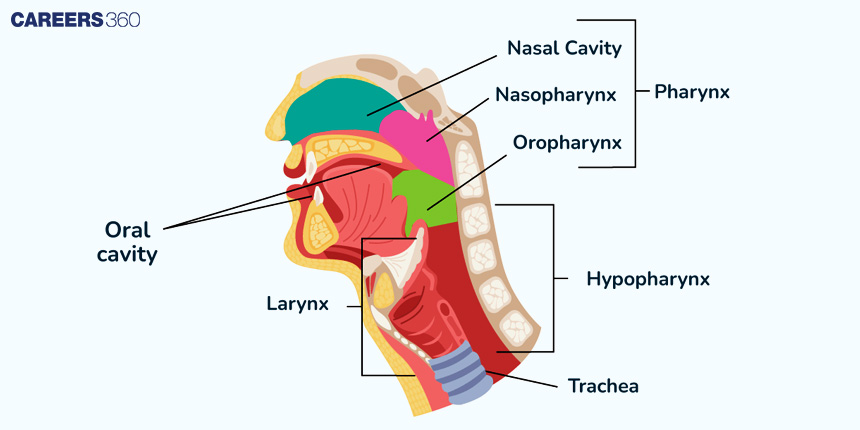Pharynx: Definition, Location, Function, Structure, Facts, Topics
Definition Of The Pharynx
The pharynx forms a portion of that part of the throat connecting the mouth and nasal cavity to the larynx and esophagus. It is the muscular tube extending from the back of the nasal cavity down across the neck that serves as a general chemoreceptive and filtering organ for the respiratory system. During deglutition—in vertebrates and a few invertebrates, the pharynx stands about three sets of organs. It might be said that there exist three pairs of branched slits that run from the exterior entering the pharynx.
NEET 2025: Mock Test Series | Syllabus | High Scoring Topics | PYQs
NEET Important PYQ's Subject wise: Physics | Chemistry | Biology
New: Meet Careers360 B.Tech/NEET Experts in your City | Book your Seat now


Position Of Pharynx
The pharynx is the cavity located at the back of oral and nasal cavities. It acts as a passage into both digestive as well as the respiratory system. In the digestive system, the pharynx opens into the oesophagus while in the respiratory system, it leads into the larynx. Changes in form and structure may occur in different organisms in accordance. It may be thick and muscular in some and turned outward or rotated in others.
Anatomy And Regions Of The Pharynx
The pharynx is divided into three related regions as follows:
Nasopharynx: The upper part behind the nasal cavity that establishes the airway through the nose.
Oropharynx: The part behind the oral cavity, which extends from the soft palate down to the level of the hyoid bone. It opens to the anterior using the mouth and posteriorly to the nasopharynx.
Laryngopharynx: This forms the most inferior part of the pharynx extending from the epiglottis downwards to the oesophagus.
The pharynx contains both sets of muscles, longitudinal and circular, which by their contraction change the shape of its lumen. The oropharynx joins the nasopharynx through an isthmus; hence, respiration through the mouth is possible. And the bolus of food can be passed into the oesophagus when needed.
General Features Of The Pharynx
Functional parts of such parts may be enumerated as follows:
Pharyngeal adenoids or tonsils: These are mucous membranes having lymphoid tissues along the wall of the nasopharynx, hence forming part of the immune host response.
Eustachian tubes: Providing an anatomic equilibration of air pressure from the middle ears opening into the pharynx.
Epiglottis: a flap of muscle closing the entrance to the pharynx from the larynx thereby preventing food from entering the trachea.
'Waldeye'r's ring': an obliquely oriented ring including the pharyngeal, tubal, palatine and lingual tonsils which work as a barrier against the micro-organisms which enter the body both by the digestive and respiratory tracts.
Functions Of The Pharynx
The pharynx performs several important functions. For example, this structure acts as a:
Passage for Air and Food: It allows the passage of air to the lungs and food to the oesophagus
Speech: It acts as a resonating chamber; sounds from the larynx are amplified in the pharynx.
Immune Defence: Pharynx lymphoid tissues act as the first line of defence against many pathogens in the body.
Warming and Humidifying Air: The air becomes warmed and humidified during its passage to the lungs.
Passing Food: Circular muscles and circular muscles will push the food down by peristalsis. Longitudinal muscles lift and flare the walls for the food to pass through.
Disorders Of The Pharynx
Following are some common disorders of the pharynx:
Pharyngitis: An infection that causes inflammation of the pharynx, whether viral or bacterial.
Tonsillitis: The infected tonsils in those cases where infections cause all other irritation and trouble, including tenderness or difficulty in swallowing.
Pharyngeal Cancer: A successive growth of cancerous tissue in the pharynx.
Sleep Apnea: The most basic variety of blocked airflow in an individual happens during rest and is brought about by the collapsing of the pharynx.
Recommended video for The Pharynx
Frequently Asked Questions (FAQs)
First, the pharynx opens into the larynx.
The pharynx refers to the throat region and acts to provide a common passage to both the respiratory and digestive systems. Gradualism from the mouth and the nose to the oesophagus and the larynx, respectively, is further aided by the pharynx. It also warms the air and pushes food portions during the act of swallowing.
This is a hollow tube made of muscular condition. The tube commences from the middle of the skull down to the cricoid cartilage to form the dorsal process of the larynx at the level of the C6 vertebra.
The pharynx can be anatomically divided into three divisions: the nasopharynx, posterior to the nasal cavity; the oropharynx, from the oral cavity down to the hyoid bone; and the laryngopharynx, from the epiglottis down to the oesophagus.
The pharynx is a common passage for respiratory and digestive passages. It provides a passageway for food, water, and air. The larynx, located above the trachea, relates to the respiratory system; moreover, it prevents food from entering the lungs and produces voice with its vocal folds.
Also Read
30 Nov'24 03:25 PM
26 Nov'24 05:38 PM
25 Nov'24 06:43 PM
25 Nov'24 05:45 PM
25 Nov'24 04:48 PM
25 Nov'24 03:52 PM
23 Nov'24 04:30 PM
23 Nov'24 10:03 AM

